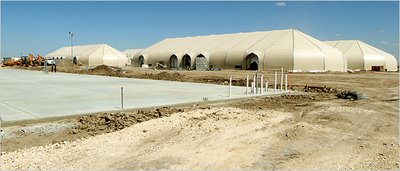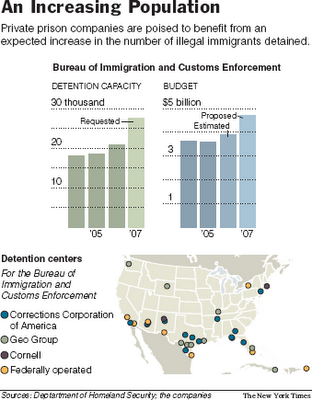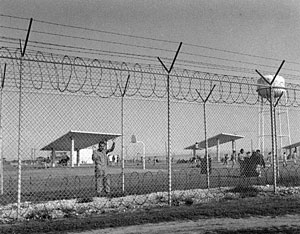The Immigrant, The Camp, and The NYSE

[Image: A detention center in Raymondsville, Tex., that can be built in 24 hours as needed. (NYT-2006)]
“Less than two months after voting overwhelmingly to build 370 miles of new fencing along the border with Mexico, the Senate yesterday voted against providing funds to build it,” recent news reported. The alleged 1.8 billion needed to complete the fence could not be allocated without sacrificing many of the other border security measures, like “750 new border-patrol agents and 1,200 new detention beds.” Well, I can’t say I am disappointed by the decision not to fund the security fence, I am concerned though to see where a large chunk of that money has gone instead, that is, the other side of their border security plan - detention beds - hardly a solution for the nation’s immigration problem. But, I must admit, not the least bit surprising.
In yesterday’s New York Times we read about the prison-industrial-complex’s latest fervor. “By the fall of 2007, the administration expects that about 27,500 immigrants will be in detention each night, an increase of 6,700 over the current number in custody. At the average cost these days of $95 a night, that adds up to an estimated total annual cost of nearly $1 billion.”

[Image: Immigration Enforcement Benefits Prison Firms, NYT, 2006.]
Who’s going to cash in on this, and who is ultimately going to pay the price? Take a guess. I’ve written before about KBR’s contract for future detention facilities, but these new contracts really seem to further institutionalize incarceration as the nation’s preferred model for dealing with anything it cannot control; carceral urbanism as a main staple in our free society's cultural landscape.
“The Corrections Corporation of America and the Geo Group — the two biggest prison operators — now house a total of fewer than 20 percent of the immigrants in detention. Currently, Corrections Corp. and Geo already run 8 of the 16 federal detention centers through out the nation." Analysts say, profit margins are higher at detention centers than prisons. Just read the Times’s article.

[Image: Mathieu Gallois, sculptural interpretation of immigration detention facility. (via)]
"Last year, the Correction Corp.’s revenue from holding immigrants jumped 21 percent, to $95 million from $70 million in 2004. Geo, the second largest prison operator, received $30.6 million last year, about the same as the year before. [..] Wall Street analysts said that detention centers produce profit margins of more than 20 percent." While contractor stocks are jumping “Federal immigration contracts generated about $95.2 million, or 8 percent, of Correction Corp.’s $1.19 billion in revenue last year, and about $30.6 million, or 5 percent, of Geo’s $612 million total income." In the first quarter of 2006, apparently Corrections Corp.’s detention revenue rose to $25.5 million. And, according to the Times, the federal immigration agency is now the company’s third-largest customer, after the federal Bureau of Prisons and the United States Marshals Service. "The detention market is projected to increase by $200 million to $250 million over the next 12 to 18 months.”

From this recent MSNBC article, “Due to a lack of space in detention facilities, 74% of non-Mexican (150,000 captured a year) illegal immigrants are released. 60% of them never show up for hearings. Those that are detained are kept in facilities that cost $35,000 a year per bed (which now total 20,800). Of course, moves to expedite removal may not work either, the US is still trying to convince China to take back 40,000 nationals here illegally."
Putting an end to the “catch an release” tactic of apprehending immigrants and releasing before deporting them, “The government also plans to detain more immigrants, especially those from countries other than Mexico, while they await their hearings.” Yeah, you guessed it, instead of figuring on strategies for strengthening Mexico's economy, the U.S. is going to put those billions into temp-to-perm jails and detention beds instead. Kind of makes one think, if the U.S. secretly welcomes the floods of immigrants so new prison industry moguls can cash in at the expense of the taxpayer, to say the very least. After all, it seems to be an industry with infinite potential.
According to this SF Chron article, “On any given day, the system overseen by U.S. Immigration and Customs Enforcement detains about 21,000 people — most for a few weeks, some for years. Some are asylum seekers; others are illegal immigrants or foreigners who had U.S. residence cards but face deportation because of run-ins with the law.”

From the same article, more than "200,000 people are detained over the course of a year in any of three types of facilities — eight run by ICE itself, six run by for-profit companies that are eager for more business, and 312 county and municipal jails that have won lucrative federal contracts and hold about 57 percent of the detainees. Advocacy groups call it a hodgepodge system that is expensive and difficult to monitor.”
The federal government says it needs around 35,000 more detention beds to hold all of the illegal immigrants that are currently awaiting deportation. As of Dec. 30, there were 544,000 such people who had merely disappeared.
From what I've read, on average detention can last from 20 to 90 days. However, conditions for the most part of these detention facilities are appalling. Judy Greene explains for Democracy Now: “In the last decade, with increased emphasis on immigrant enforcement, the immigrant detention system, the little industry, has tripled in size to a capacity now of some 22,000 beds. Some of these beds are private. Some of these beds are operated by ICE. Some of these beds are in jails. But the private sector is gobbling up an increasing share of these resources. Now, since 9/11, there's been an increased blurring of the line between immigrant enforcement and law enforcement. And now, with the hyper-politicized immigration reform debate, we're seeing bills that would completely erase that line.”

Mark Dow also adds, “The reason I use the phrase "immigration prisons" is because we talk a lot about detention. We’re hearing a lot about detention. But when people are detained, they are incarcerated. They are prisoners. They're stripped of their clothing. They’re given inmate uniforms. It's not that they're treated like prisoners, they are prisoners. So even though this is administrative, quote-unquote, “detention,” it has nothing to do with serving time for a sentence. These people are jailed as prisoners, and they are in jails, they are in prisons, and sometimes in what are called detention centers or processing centers, but as a warden once told me, these are all the same thing."
And Dow goes onto say, "Part of the problem for these immigration prisoners, like some of the ones that have been talking to you today, is that they are isolated from families. They're isolated from legal help. They are often put in rural areas, where there simply aren't lawyers in the area who can help them. And none of that is an accident. In fact, often if immigration prisoners are in a big city, where they might have legal help or family support, the immigration agency, ICE, will often move them to isolated rural areas to make sure that they're more cut off and more isolated. So the immigration service actively works to cut them off from the little due process that's available to them.”
Another large misconception is that illegal immigration across the border has increased dramatically since 9/11. However, “According to the Pew Hispanic Center in Washington, the number of unauthorized immigrants arriving in this country is down by about 50,000 a year from the late 1990’s.”
Anyway, with all that said, be sure to check out the Camp Campaign project, which explores the phenomoenon of "the camp" (in all it's forms: Gitmo, prisons, labor camps, internment camps, refugee camps, detention camps, etc), and "its relation to other phenomenon we are confronted with in the social and political landscape." The Camp as "a more acute or extreme version of what is taking place around us in the name of security," in a "state of exception, in this case, the suspension of the rule of law (e.g., Patriot Act, illegal combatants, military tribunals, extraordinary rendition, Guantanamo Bay), have become increasingly common devices of governance, perhaps the norm, in "democratic" states in this last century."
(Thanks to Geoff for the NYT article, and to Critical Spatial Practice for the Camp Campaign project, and thanks to the Javinator, too)







1 Comments:
Excellent site - thank you for providing such a great resource. I will definitely link to your site from my home page.
Post a Comment
<< Home